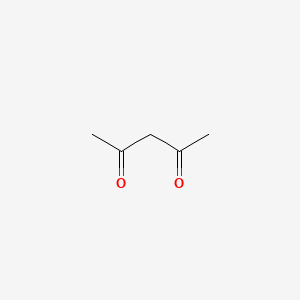| MeSH term | MeSH ID | Detail |
|---|---|---|
| Purpura, Thrombocytopenic | D011696 | 2 associated lipids |
| Eczema | D004485 | 4 associated lipids |
| Fetal Resorption | D005327 | 15 associated lipids |
| Carcinoma, Lewis Lung | D018827 | 22 associated lipids |
| Nervous System Diseases | D009422 | 37 associated lipids |
| Dermatitis, Contact | D003877 | 59 associated lipids |
| Seizures | D012640 | 87 associated lipids |
| Glioma | D005910 | 112 associated lipids |
| Edema | D004487 | 152 associated lipids |
| Adenocarcinoma | D000230 | 166 associated lipids |
2,4-pentanedione
2,4-pentanedione is a lipid of Fatty Acyls (FA) class. The related lipids are Butyrates.
Cross Reference
Introduction
To understand associated biological information of 2,4-pentanedione, we collected biological information of abnormalities, associated pathways, cellular/molecular locations, biological functions, related genes/proteins, lipids and common seen animal/experimental models with organized paragraphs from literatures.
What diseases are associated with 2,4-pentanedione?
There are no associated biomedical information in the current reference collection.
Possible diseases from mapped MeSH terms on references
We collected disease MeSH terms mapped to the references associated with 2,4-pentanedione
PubChem Associated disorders and diseases
What pathways are associated with 2,4-pentanedione
There are no associated biomedical information in the current reference collection.
PubChem Biomolecular Interactions and Pathways
Link to PubChem Biomolecular Interactions and PathwaysWhat cellular locations are associated with 2,4-pentanedione?
There are no associated biomedical information in the current reference collection.
What functions are associated with 2,4-pentanedione?
There are no associated biomedical information in the current reference collection.
What lipids are associated with 2,4-pentanedione?
Related references are published most in these journals:
| Lipid concept | Cross reference | Weighted score | Related literatures |
|---|
What genes are associated with 2,4-pentanedione?
There are no associated biomedical information in the current reference collection.
What common seen animal models are associated with 2,4-pentanedione?
There are no associated biomedical information in the current reference collection.
NCBI Entrez Crosslinks
All references with 2,4-pentanedione
Download all related citations| Authors | Title | Published | Journal | PubMed Link |
|---|---|---|---|---|
| Ikarashi Y et al. | [Examination related to revised test method for determination of formaldehyde, regulated by the law for the control of household products containing harmful substances]. | 2003 | Kokuritsu Iyakuhin Shokuhin Eisei Kenkyusho Hokoku | pmid:14740400 |
| Palmiere C et al. | Blood, urine and vitreous isopropyl alcohol as biochemical markers in forensic investigations. | 2012 | Leg Med (Tokyo) | pmid:22177827 |
| Karim MM et al. | Application of a lanthanide composite nanoparticle-sensitized luminescence method for the determination of salicylic acid in pharmaceutical formulations and human plasma. | 2008 Nov-Dec | Luminescence | pmid:18816464 |
| Peng Q et al. | A new spectrofluorimetric method for determination of trace amounts histamine in human urine and serum. | 2009 May-Jun | Luminescence | pmid:19367656 |
| McFarland EW et al. | Chemical exchange magnetic resonance imaging (CHEMI). | 1988 Sep-Oct | Magn Reson Imaging | pmid:2852290 |
| Brooker S et al. | The co-distribution of Plasmodium falciparum and hookworm among African schoolchildren. | 2006 | Malar. J. | pmid:17083720 |
| Kelly GC et al. | Modern geographical reconnaissance of target populations in malaria elimination zones. | 2010 | Malar. J. | pmid:20961423 |
| Mishra L et al. | Studies on Some New Ru(III) Complexes Using aryl-azo Pentane- 2,4-dione and 2,6-bis (2'-Benzimidazolyl) Pyridine as Ligands: Synthesis, Spectroscopic, Luminescent, Electrochemical and Biological Activities. | 2001 | Met Based Drugs | pmid:18475977 |
| Mishra AP and Soni M | Synthesis, structural, and biological studies of some schiff bases and their metal complexes. | 2008 | Met Based Drugs | pmid:18670613 |
| De Pascali SA et al. | Mutagenic Tests Confirm That New Acetylacetonate Pt(II) Complexes Induce Apoptosis in Cancer Cells Interacting with Nongenomic Biological Targets. | 2011 | Met Based Drugs | pmid:21792272 |
